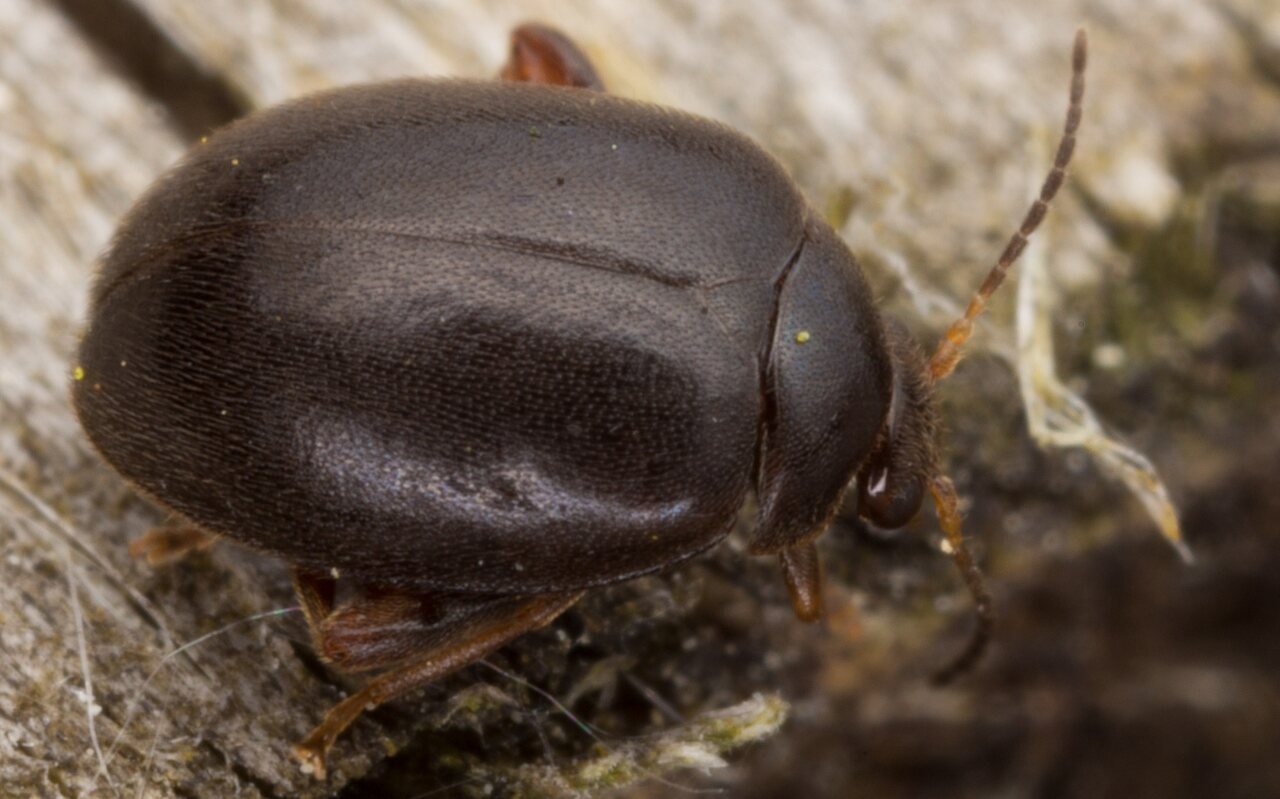
Scirtes hemisphaericus · liūnvabalis
- Chrysomela hemisphaerica
- Kurzovaler Sumpfkäfer
- hyppykaavikas
- hulaczek ciemny
Body oval, domed, shiny. Pronotum black or reddish brown. Elytra usually black covered with relatively short hairs. Hind thighs thickened. Antennae lighter in the basal part.
This species is locally common throughout lowland Europe north to the UK and southern provinces of Fennoscandia. Adults occur over a short season from late May until August, typical habitats are well-vegetated margins of ponds, lakes and reservoirs but they also occur in other wetland areas such as swamps, bogs and permanently wet areas in open woodland. They are crepuscular and nocturnal and frequently come to light but they rest by day on emergent leaves of reeds and rushes and are easily sampled by sweeping, during hot weather they occasionally become active by day and may be netted in flight, and towards the evening they may swarm in large numbers on marginal shrubs and vegetation. Mating occurs in the evening and females oviposit on or within plant stems below the water surface, the tiny dark and elongate larvae develop in the water, living among the substrate where they feed on algae, fungi and organic detritus, but they have well-developed legs and sharp claws and are capable of climbing submerged stems and foliage. Pupation occurs on aquatic stems of emergent plants, these are used to supply the pupa and the freshly-emerged adult with oxygen; the fully grown larva bites into a stem until the parenchyma is exposed and then it pupates in situ, the newly formed pupa forces its forebody into the stem where it becomes surrounded with a film of air connected to the plant intracellular air and thus to the atmosphere, the adult emerges between the pro- and mesothorax while the pupa remains connected to the stem and so it can breath and remain submerged for an extended period before climbing the stem and leaving the water. Adults are easy to see as they rest by day and they may be swept at any time, they tend to move slowly but can jump powerfully and seem to vanish from the net and so some care needs to be taken when sampling them.
2.5-3.5 mm. Broadly oval, convex and rounded in outline, finely pubescent and entirely dark brown to black with the appendages a little paler and the antennal bases yellow. Head transverse, broadest across convex and protruding eyes and produced forward to a truncate apical margin, terminal maxillary palpomere pyriform and pointed. Antennae inserted laterally in front of the eyes, 11-segmented, the basal segment broad and expanded near the apex, second and third segments small and subequal in length, the remainder long and narrow. Pronotum transverse, about 3:1, broadest across acute posterior angles and smoothly rounded anteriorly, surface evenly convex and very finely punctured throughout. Elytra elongate and smoothly curved to separately rounded apical margins, without striae, moderately strongly and densely punctured throughout, the punctures discrete and in places separated by their own diameter, pubescence fine and dark yellow in colour. Front and middle legs slender, the femora not normally visible in set specimens, tibiae hardly broadened from the base and with small and fine apical spurs. Hind femora greatly enlarged, tibiae narrow and slender, with two long apical spurs, the dorsal spur almost as long as the first tarsal segment and the ventral spur about half as long, in males the inner margin of the longer spur is straight. Tarsi 5-segmented; the front and middle tarsi normally developed, the basal segment of the rear tarsi longer than the others combined, fourth segment of all tarsi widely bilobed.
‥
0 comments
Add a comment